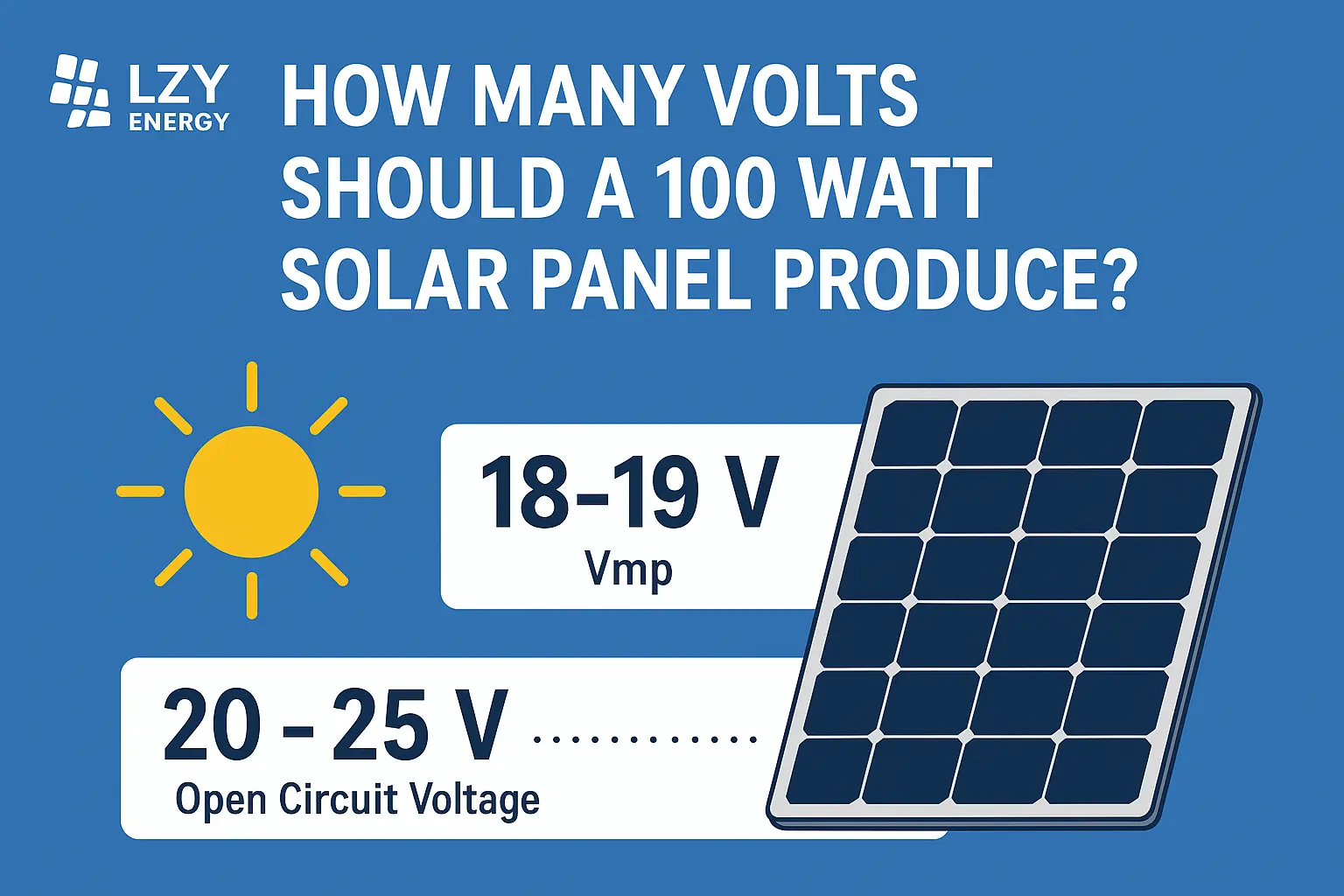What’s the Real Voltage of a 100-Watt Solar Panel?
Let’s get right to the point: a 100-watt solar panel typically produces around 18–19 volts at its maximum power point (Vmp) under ideal conditions. However, the open-circuit voltage (Voc)—the voltage measured when no current is flowing—can reach 20–25 volts depending on the brand, temperature, and sunlight intensity.
At LZY Energy, our 100W monocrystalline panels usually operate around 18.6V Vmp and 21.8V Voc, designed to pair perfectly with 12V battery systems for efficient charging.
But here’s the twist: that voltage figure isn’t constant. It fluctuates throughout the day.
Key Voltage Terms You Should Know
Before we go deeper, let’s decode the jargon you’ll see on every solar panel spec sheet:
| Term | Description | Typical Value for 100W Panel |
| Vmp (Maximum Power Voltage) | The voltage where the panel produces its rated 100 watts | 18–19V |
| Voc (Open Circuit Voltage) | Voltage with no load; used to size controllers and inverters | 20–25V |
| Imp (Maximum Power Current) | The current when the panel is producing its rated output | ~5.5A |
| Isc (Short Circuit Current) | Maximum possible current if the circuit is shorted | ~6.0A |
Why Voltage Isn’t Always the Same
If your solar panel were a person, voltage would be its mood — highly sensitive to the environment. Here’s why:
Temperature:
Cold weather = higher voltage.
When the panel cools, electrons move less and create a slightly stronger potential difference.
Hot weather = lower voltage.
On a scorching summer day, the voltage can drop by 2–3 volts due to increased resistance.
Sunlight Intensity:
The more sunlight your panel gets, the closer it operates to its rated Vmp.
Overcast conditions can drop voltage (and current) significantly.
Panel Design:
Different cell configurations or manufacturers yield slightly different voltage characteristics.
For example, LZY Energy’s 100W panels use high-efficiency monocrystalline cells with 23% conversion efficiency, maintaining stable voltage output even on cloudy days.
What Does Voltage Mean for Your Solar Setup?
Here’s where things get practical. A 100W panel producing 18V might sound random — but that number is intentional. It’s perfect for charging a 12V battery.
Why?
Because batteries need a slightly higher voltage than their nominal rating to charge efficiently.
For instance:
A 12V LiFePO4 battery typically charges around 14.4V.
Your solar panel provides ~18V, allowing room for voltage drops in wires and controllers.
That’s why most 100W panels are paired with PWM or MPPT charge controllers — devices that regulate voltage and current to prevent overcharging.
Matching Your Panel to the Right Charge Controller
Choosing the right charge controller is as crucial as pairing wine with dinner — get it wrong, and things get messy.
- PWM Controller: Works best when panel voltage is close to battery voltage. Ideal for simple 12V systems.
- MPPT Controller: Converts excess panel voltage into usable current, boosting efficiency by up to 30%.
If your 100W panel has a Voc of 22V, make sure your charge controller’s input voltage limit is higher than that—preferably 30V or more—to avoid damage.
Real-World Example: Calculating Output Power
Let’s crunch a quick example (don’t worry, no heavy math here):
A 100W panel operating at Vmp = 18V will deliver about 5.5 amps of current (100 ÷ 18 = 5.55A).
So on a sunny day, if your area gets 5 peak sun hours, that’s roughly:
100W × 5h = 500 watt-hours per day
In reality, expect 300–450 Wh, considering efficiency losses and weather variations. That’s enough to charge:
- 4–5 smartphones
- A laptop
- A small fan
- Or keep LED lights running all evening in your RV
Not bad for something that fits in your backpack.
How Temperature and Weather Affect Voltage (with Data)
Studies show that for every 1°C rise in panel temperature, voltage drops by about 0.3–0.4%.
That means if your 100W panel’s Vmp is 18V at 25°C, it could fall to about 17V at 45°C — a small but noticeable change.
Cold climates, on the other hand, can push Voc up to 24V or more.
That’s why professional installers always calculate temperature coefficients and worst-case voltage scenarios before designing a solar array.
Common Use Cases for 100W Solar Panels
The humble 100-watt solar panel is one of the most versatile and practical choices for off-grid power solutions.Whether it’s camping, RV trips, or powering a tiny cabin, this size offers flexibility without overkill.
Common setups include:
- Portable Power Stations: Pair your LZY Energy 100W panel with a LiFePO4 power station for easy charging anywhere.
- 12V RV Systems: Two or three 100W panels can comfortably power lights, fans, and a small fridge.
- Boats & Vans: Ideal for trickle-charging batteries or maintaining power in off-grid living situations.
Fun Thought: Can a 100W Solar Panel Power Your Home?
Technically, yes. Practically, no.
A standard home consumes around 900–1200 kWh per month. You’d need about 100 of these panels — plus a very large roof and budget.
So unless you’re building a solar palace, a 100W panel is better for small-scale use.
Still, it’s a great entry point for anyone exploring renewable energy. And who knows? You might start with one panel and end up with a full off-grid system.
In short: A 100-watt solar panel should produce about 18–19 volts under load and 20–25 volts open circuit. That voltage sweet spot is what makes it perfect for 12V systems, powering everything from camping gear to portable stations — especially when you trust reliable products like those from LZY Energy.

